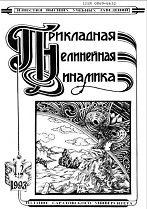|
This article is cited in 1 scientific paper (total in 1 paper)
NONLINEAR DYNAMICS AND NEUROSCIENCE
Neurodynamic model for creative cognition of relational networks with even cyclic inhibition
V. D. Tsukerman
Academy of Biology and Biotechnology of Southern Federal University, Rostov-on-Don, Russia
Abstract:
The purpose of this work is study of the neurodynamic foundations of the creative activity of the brain. Modern AI systems using deep neural network training require large amounts of input data, high computational costs and long training times. On the contrary, the brain can learn from small datasets in no time and, crucially, it is fundamentally creative. Methods. The study was carried out through computational experiments with neural networks containing 5 and 7 oscillatory layers (circuits) trained to represent abstract concepts of a certain class of animals. The scheme of neural networks with even cyclic inhibition (ECI networks) contains only bilateral inhibitory connections and consists of two subnets: a reference noncoding network, which is an analogue of the default brain mode neural network, and the main information network that receives time sequences of environmental signals and contextual inputs. After training, the reading of the population phase codes was performed with a simple linear decoder. Results. Conceptual learning of the network leads to the generation of a number of spatial abstract images that are distinguished by the most pronounced features of the relevant line of animals. In computational experiments, a wide set of isomorphic representations of concepts was obtained through: a) transformations of image spaces in a wide range of time scales of the training input signal flow, b) internal regulation of the time scales of mental representations of concepts, c) confirmation on the model of the dependence of psychological proximity of concepts on semantic distance; d) calling from memory (decoding) distributed groups of neurons of animal concepts, which the network has not been trained in. Conclusion. This paper shows for the first time how, using a small set of event input data (a sequence of 4 CCW and 2 CW signals) and very limited computational resources, ECI networks exhibit creative cognitions based on relational relationships, conceptual learning and generalization of knowledge.
Keywords:
conceptual learning, imagination, semantic space, generalization.
Received: 17.11.2021
Citation:
V. D. Tsukerman, “Neurodynamic model for creative cognition of relational networks with even cyclic inhibition”, Izvestiya VUZ. Applied Nonlinear Dynamics, 30:3 (2022), 331–357
Linking options:
https://www.mathnet.ru/eng/ivp482 https://www.mathnet.ru/eng/ivp/v30/i3/p331
|

| Statistics & downloads: |
| Abstract page: | 73 | | Full-text PDF : | 67 | | References: | 6 |
|




 Contact us:
Contact us: Terms of Use
Terms of Use
 Registration to the website
Registration to the website Logotypes
Logotypes








 Citation in format
Citation in format 
